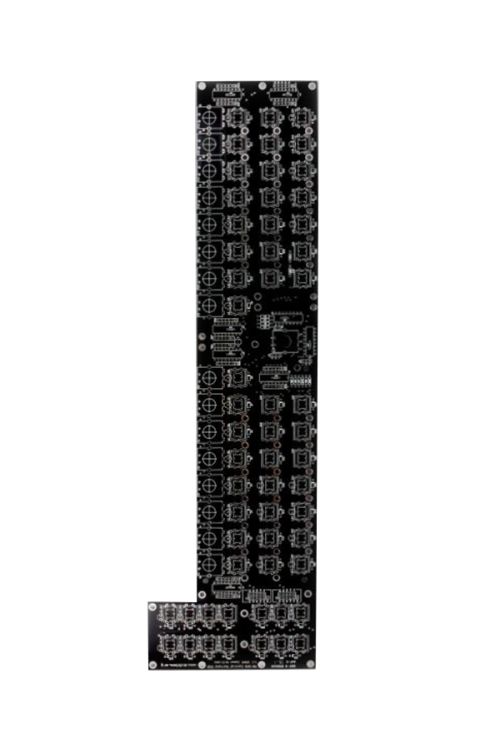SEQ V4 - Sequencer Control PCB | MIDIbox
- Home
- Format
- Desktop/Standalone
- SEQ V4 - Sequencer Control PCB | MIDIbox
SEQ V4 - Sequencer Control PCB | MIDIbox
Special Price
$36.00
Regular Price
$40.00
MIDIBox SEQ V4 is the fourth generation of the MIDIbox DIY sequencer project.
This is for a PCB ONLY in a standalone/MIDIbox format.
Availability:In stock
BrandMIDIbox/ ucApps.de
MIDIbox SEQ V4 Teaser #2 from Thorsten Klose on Vimeo.
The MIDIbox SEQ V4 is based on Wilba's frontpanel, and the "traditional" variant which is based on the MIDIbox SEQ V3 hardware with a replaced core module. Both are running with the same firmware, so that you won't miss any software feature!
Wilba's frontpanel greatly reduces the complexity of the hardware, and is therefore the prefered choice. The traditional variant is still interesting if you want to create a fully customized version of the sequencer, with a different layout and dedicated buttons/LEDs
Features:
- optimized for live playing and editing
- intuitive user interface with flat menu hierarchy, wide screen display (2 * 2x40 = 160 characters) and 16+1 rotary encoders with menu page dependent "soft function".
- multiple MIDI Out ports (up to 12) for reduced MIDI latency
- up to 4 MIDI In ports (e.g. for separated MIDI clock and MIDI keyboard inputs)
- USB interface which supports USB MIDI protocol to send events more than 100 times faster
- optional Ethernet interface for sending/receiving OSC packets (or MIDI events embedded into OSC packets)
- every parameter can be modified in realtime w/o affecting the sequencer timings
- one sequencer pattern consists of 4 independent tracks
- four patterns can be played at the same time -> makes 16 tracks
- each track consists of up to 16 layers which can be assigned to various parameters (e.g. Note/Velcity/Gatelength/Chords/CC/PitchBender/Delay/Probability/Roll)
- Transpose and Arpeggiator function
- Force-to-Scale function with 166 predefined scales
- Track directions: Forward/Backward/PingPong/Pendulum/Random Dir/Random Step
- Track direction progressive parameters (Step Forward, Jump Back, Repeat, Interval, Skip, Repeat)
- free adjustable clock divider for each track. Supported timebases 1..256, normal and tripled
- available length for every track: 1-256 steps
- with 384ppqn resolution, 256th notes can be played
- loop point within track
- step events can be triggered multiple times (up to 4 times per step) with a delay value of 1-31 to realize drumrolls, ratterbeats, flams...
- 8 trigger layers for Gate/Skip/Accent/Glide/Roll/Random Gate/Random Value/No Fx
- various Groove styles (shuffle/inverted shuffle/...) + customizable Groove Templates (Delay/Length/Velocity)
- Humanizer function (random modification of note/velocity/gatelength)
- Pattern Morphing, controllable in 128 steps with a Modulation Wheel
- Echo Fx with Repeat/Delay/Feedback/Note increment/Gatelength/Delay parameters
- LFO Fx with different waveforms, synchronized period length, adjustable reset point, phase, OneShot mode. Assignable to Note/Velocity/Length/CC
- Note Limiter Fx
- Manual step triggering
- Step and Realtime Record function
- Copy/Paste/Clear function
- Scroll and Step Move function
- Random and Euclidean pattern generator
- Undo function
- parameters of multiple steps can be changed relatively and absolutely with a single rotary encoder
- parameters of multiple tracks can be changed the same time with a single rotary encoder
- Tracks and parameter layers can be muted
- Accent/Slide/CC sequences
- inbuilt MIDI mixer/controller with 128 free definable mixer maps
- inbuilt MIDI router
- virtual "Loopback port" for Master/Slave tracks
- split function for Transposer/Arpeggiator
- 8 optional CV outputs and gates for analog gear
- CV outputs can also be accessed from MIDI In (-> replaces a CV interface)
- 64 optional 1 mS drum trigger outputs
- 8*128 patterns are stored on SD Card
- 128 mixer maps are stored on SD Card
- pattern sets can be looped and chained in song mode
- phrase mode which allows to switch between the 16 predefined pattern sets (for fills/breaks/chorus, etc...)
- pattern switching can be synchronized to the measure
- MIDI Remote functions
- 2.5-300 BPM (MIDI clock master)
- external sync (MIDI clock slave)
- DIN sync output for controlling vintage sequencers
- works with 16x MIDI clock resolution (384 ppqn)
- several hardware options (e.g. a 64 Button/Duo-LED matrix)
- details and demo samples in the User Manual
So, to build a basic MIDIbox SEQ V4, you will need:
-
Either a CORE_STM32F4 (with MIDI I/O board) or a CORE_LPC17 PCB;
-
MIDIbox SEQ V4 Control PCB (the pcb you're currently looking at);
-
Two 40×2 LCD displays;
-
IDC Ribbon cables and connectors to connect the PCBs and LCDs; and
-
the parts required to populate the PCBs.
| Brand | MIDIbox/ ucApps.de |
|---|---|
| Additional Resources | MB-SEQ-V4 Getting Started Parts Guide Construction Guide User Manual Front Panel Express Panel File Additional Reading |

